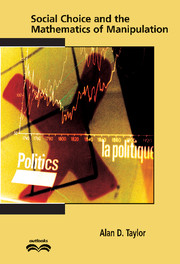Social Choice and the Mathematics of Manipulation
Part of Outlooks
- Author: Alan D. Taylor, Union College, New York
- Date Published: May 2006
- availability: This ISBN is for an eBook version which is distributed on our behalf by a third party.
- format: Adobe eBook Reader
- isbn: 9780511113734
Find out more about Cambridge eBooks
Adobe eBook Reader
Other available formats:
Paperback, Hardback
Looking for an inspection copy?
This title is not currently available on inspection
-
Honesty in voting, it turns out, is not always the best policy. Indeed, in the early 1970s, Allan Gibbard and Mark Satterthwaite, building on the seminal work of Nobel laureate Kenneth Arrow, proved that with three or more alternatives there is no reasonable voting system that is non-manipulable; voters will always have an opportunity to benefit by submitting a disingenuous ballot. The ensuing decades produced a number of theorems of striking mathematical naturality that dealt with the manipulability of voting systems. This 2005 book presents many of these results from the last quarter of the twentieth century, especially the contributions of economists and philosophers, from a mathematical point of view, with many new proofs. The presentation is almost completely self-contained, and requires no prerequisites except a willingness to follow rigorous mathematical arguments. Mathematics students, as well as mathematicians, political scientists, economists and philosophers will learn why it is impossible to devise a completely unmanipulable voting system.
Read more- This is the only book that tries to bring together the main results from the last quarter of the twentieth century that deal with the manipulability of voting systems
- This is a unified treatment; a vast majority of the proofs are new
- This is a self-contained treatment; there are no prerequisites except a willingness to follow mathematical arguments
Reviews & endorsements
'… well organised and clearly written, with subtle differences in similar situations being deftly dealt with. In conclusion, this book is a little gem. It will be especially prized by those who need to understand voting systems and how they can be manipulated by individual voters.' Mathematics Today
See more reviews'Overall, I think this book is the must-have-on-the-shelf for scholars interested in social choice, including economists, philosophers, mathematicians, and political scientists. If a reader takes the effort to go through the book thoroughly, the benefits, in my opinion, would be enormous.' Psychometrika
Customer reviews
Not yet reviewed
Be the first to review
Review was not posted due to profanity
×Product details
- Date Published: May 2006
- format: Adobe eBook Reader
- isbn: 9780511113734
- copublisher: The Mathematical Association of America
- contains: 3 b/w illus. 80 exercises
- availability: This ISBN is for an eBook version which is distributed on our behalf by a third party.
Table of Contents
1. Introduction
2. The Gibbard–Satterthwaite theorem
3. Additional results for single-valued elections
4. The Duggan–Schwartz theorem
5. Additional results for multi-valued elections
6. Ballots that rank sets
7. Elections with outcomes that are lotteries
8. Elections with variable agendas
References
Index.Instructors have used or reviewed this title for the following courses
- Mathematics: Prediction, Persuasion and Politics
Sorry, this resource is locked
Please register or sign in to request access. If you are having problems accessing these resources please email [email protected]
Register Sign in» Proceed
You are now leaving the Cambridge University Press website. Your eBook purchase and download will be completed by our partner www.ebooks.com. Please see the permission section of the www.ebooks.com catalogue page for details of the print & copy limits on our eBooks.
Continue ×Are you sure you want to delete your account?
This cannot be undone.
Thank you for your feedback which will help us improve our service.
If you requested a response, we will make sure to get back to you shortly.
×


